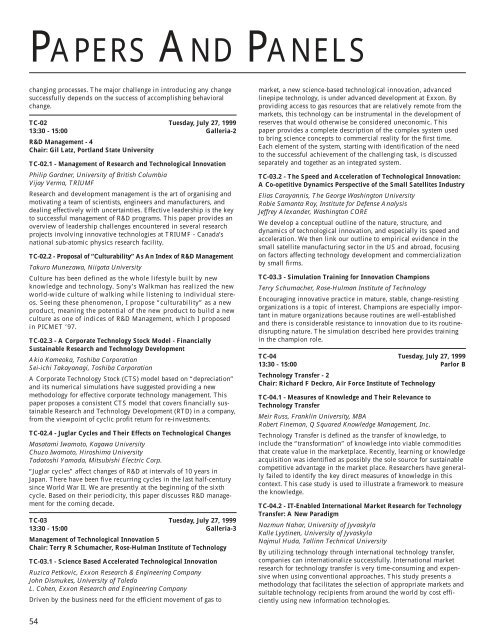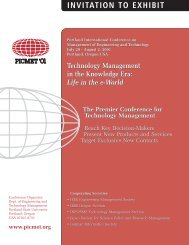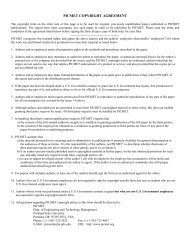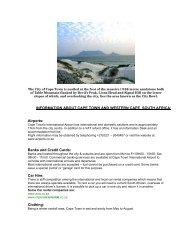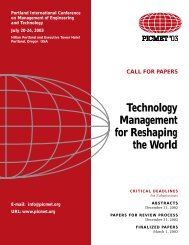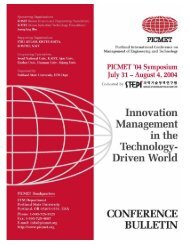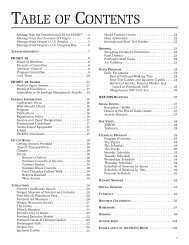Technology & Innovation Management: - PICMET Conference
Technology & Innovation Management: - PICMET Conference
Technology & Innovation Management: - PICMET Conference
Create successful ePaper yourself
Turn your PDF publications into a flip-book with our unique Google optimized e-Paper software.
PAPERS AND PANELS<br />
changing processes. The major challenge in introducing any change<br />
successfully depends on the success of accomplishing behavioral<br />
change.<br />
TC-02 Tuesday, July 27, 1999<br />
13:30 - 15:00 Galleria-2<br />
R&D <strong>Management</strong> - 4<br />
Chair: Gil Latz, Portland State University<br />
TC-02.1 - <strong>Management</strong> of Research and Technological <strong>Innovation</strong><br />
Philip Gardner, University of British Columbia<br />
Vijay Verma, TRIUMF<br />
Research and development management is the art of organising and<br />
motivating a team of scientists, engineers and manufacturers, and<br />
dealing effectively with uncertainties. Effective leadership is the key<br />
to successful management of R&D programs. This paper provides an<br />
overview of leadership challenges encountered in several research<br />
projects involving innovative technologies at TRIUMF - Canada’s<br />
national sub-atomic physics research facility.<br />
TC-02.2 - Proposal of “Culturability” As An Index of R&D <strong>Management</strong><br />
Takuro Munezawa, Niigata University<br />
Culture has been defined as the whole lifestyle built by new<br />
knowledge and technology. Sony’s Walkman has realized the new<br />
world-wide culture of walking while listening to individual stereos.<br />
Seeing these phenomenon, I propose “culturability” as a new<br />
product, meaning the potential of the new product to build a new<br />
culture as one of indices of R&D <strong>Management</strong>, which I proposed<br />
in <strong>PICMET</strong> ’97.<br />
TC-02.3 - A Corporate <strong>Technology</strong> Stock Model - Financially<br />
Sustainable Research and <strong>Technology</strong> Development<br />
Akio Kameoka, Toshiba Corporation<br />
Sei-ichi Takayanagi, Toshiba Corporation<br />
A Corporate <strong>Technology</strong> Stock (CTS) model based on “depreciation”<br />
and its numerical simulations have suggested providing a new<br />
methodology for effective corporate technology management. This<br />
paper proposes a consistent CTS model that covers financially sustainable<br />
Research and <strong>Technology</strong> Development (RTD) in a company,<br />
from the viewpoint of cyclic profit return for re-investments.<br />
TC-02.4 - Juglar Cycles and Their Effects on Technological Changes<br />
Masatami Iwamoto, Kagawa University<br />
Chuzo Iwamoto, Hiroshima University<br />
Tadatoshi Yamada, Mitsubishi Electric Corp.<br />
“Juglar cycles” affect changes of R&D at intervals of 10 years in<br />
Japan. There have been five recurring cycles in the last half-century<br />
since World War II. We are presently at the beginning of the sixth<br />
cycle. Based on their periodicity, this paper discusses R&D management<br />
for the coming decade.<br />
TC-03 Tuesday, July 27, 1999<br />
13:30 - 15:00 Galleria-3<br />
<strong>Management</strong> of Technological <strong>Innovation</strong> 5<br />
Chair: Terry R Schumacher, Rose-Hulman Institute of <strong>Technology</strong><br />
TC-03.1 - Science Based Accelerated Technological <strong>Innovation</strong><br />
Ruzica Petkovic, Exxon Research & Engineering Company<br />
John Dismukes, University of Toledo<br />
L. Cohen, Exxon Research and Engineering Company<br />
Driven by the business need for the efficient movement of gas to<br />
market, a new science-based technological innovation, advanced<br />
linepipe technology, is under advanced development at Exxon. By<br />
providing access to gas resources that are relatively remote from the<br />
markets, this technology can be instrumental in the development of<br />
reserves that would otherwise be considered uneconomic. This<br />
paper provides a complete description of the complex system used<br />
to bring science concepts to commercial reality for the first time.<br />
Each element of the system, starting with identification of the need<br />
to the successful achievement of the challenging task, is discussed<br />
separately and together as an integrated system.<br />
TC-03.2 - The Speed and Acceleration of Technological <strong>Innovation</strong>:<br />
A Co-opetitive Dynamics Perspective of the Small Satellites Industry<br />
Elias Carayannis, The George Washington University<br />
Robie Samanta Roy, Institute for Defense Analysis<br />
Jeffrey Alexander, Washington CORE<br />
We develop a conceptual outline of the nature, structure, and<br />
dynamics of technological innovation, and especially its speed and<br />
acceleration. We then link our outline to empirical evidence in the<br />
small satellite manufacturing sector in the US and abroad, focusing<br />
on factors affecting technology development and commercialization<br />
by small firms.<br />
TC-03.3 - Simulation Training for <strong>Innovation</strong> Champions<br />
Terry Schumacher, Rose-Hulman Institute of <strong>Technology</strong><br />
Encouraging innovative practice in mature, stable, change-resisting<br />
organizations is a topic of interest. Champions are especially important<br />
in mature organizations because routines are well-established<br />
and there is considerable resistance to innovation due to its routinedisrupting<br />
nature. The simulation described here provides training<br />
in the champion role.<br />
TC-04 Tuesday, July 27, 1999<br />
13:30 - 15:00 Parlor B<br />
<strong>Technology</strong> Transfer - 2<br />
Chair: Richard F Deckro, Air Force Institute of <strong>Technology</strong><br />
TC-04.1 - Measures of Knowledge and Their Relevance to<br />
<strong>Technology</strong> Transfer<br />
Meir Russ, Franklin University, MBA<br />
Robert Fineman, Q Squared Knowledge <strong>Management</strong>, Inc.<br />
<strong>Technology</strong> Transfer is defined as the transfer of knowledge, to<br />
include the “transformation” of knowledge into viable commodities<br />
that create value in the marketplace. Recently, learning or knowledge<br />
acquisition was identified as possibly the sole source for sustainable<br />
competitive advantage in the market place. Researchers have generally<br />
failed to identify the key direct measures of knowledge in this<br />
context. This case study is used to illustrate a framework to measure<br />
the knowledge.<br />
TC-04.2 - IT-Enabled International Market Research for <strong>Technology</strong><br />
Transfer: A New Paradigm<br />
Nazmun Nahar, University of Jyvaskyla<br />
Kalle Lyytinen, University of Jyvaskyla<br />
Najmul Huda, Tallinn Technical University<br />
By utilizing technology through international technology transfer,<br />
companies can internationalize successfully. International market<br />
research for technology transfer is very time-consuming and expensive<br />
when using conventional approaches. This study presents a<br />
methodology that facilitates the selection of appropriate markets and<br />
suitable technology recipients from around the world by cost efficiently<br />
using new information technologies.<br />
54


